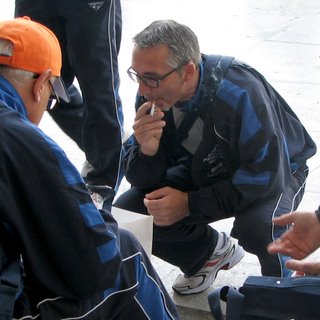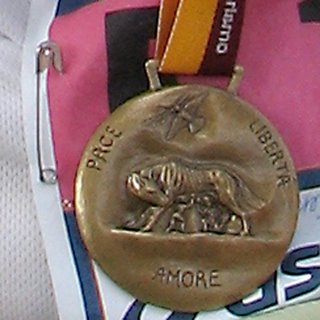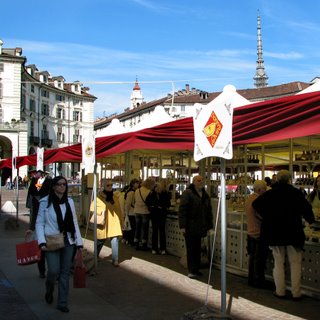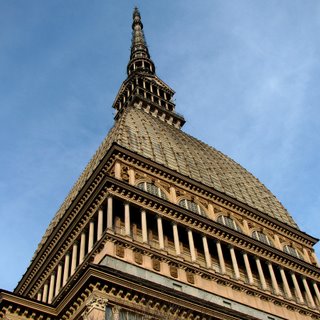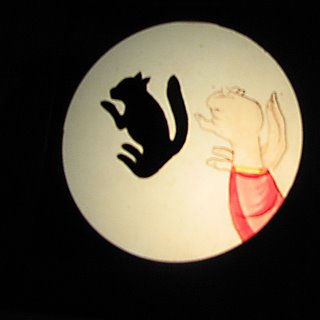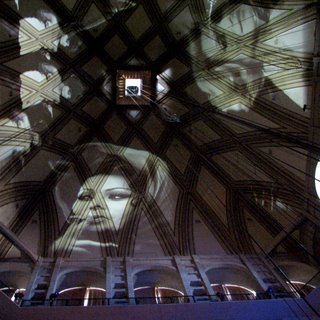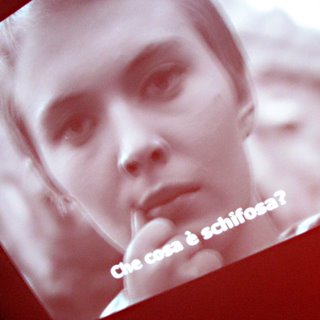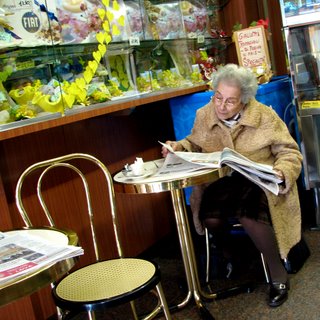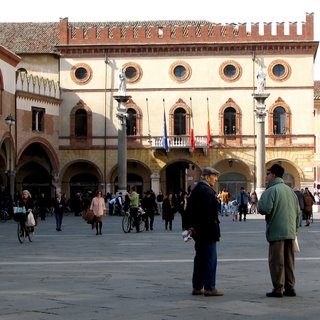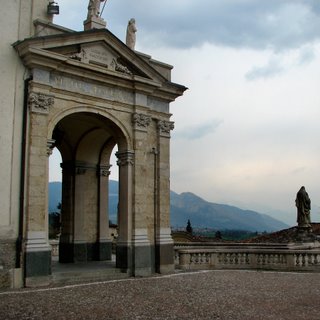
Why do we love Clusone? Is it the frescoes? The clock? The mountains? Yes, yes and yes but... it's also the people. There's the restaurant owner who cracked open his front door to lean out and bellow a friend's name towards the clock tower. And the young man at the cheese shop who carefully wrapped each of our cheese chunks in wax paper and then gently transcribed the name of each cheese on its paper-wrapper. And the shopkeeper who gave us spoonfuls of the bitter honey that her husband had collected in Sardinia.
Clusone was everything our Italian small town guidebook predicted. It was quaint and charming, a hamlet lingering in the hills. With snow caps rising in the distance and air that's fresh and crisp. We arrived there by bus from Bergamo, our travel time from Milan totaling about 2 hours with train and bus rides added together. But Milan felt light years away.

We spent the morning shopping for fabulous foods (pastries, cheeses, bread) because we've learned that if you don't explore shops before the lunchtime closing you may not get to explore them at all. Saturdays after 1:00pm are far from ideal for shopping in this country. If you're lucky, a store might open again around 3:30 or 4pm when the owner returns from a splendid lunch taken casually over a period of several hours. And if you're not lucky, you'll be on your bus headed home wondering why you didn't get pastries when you had the chance.
When we finally made our way to lunch - in an empty but nevertheless homey trattoria - we were happy to take a break and sit down to a giant plate of meats and cheese. And lardo. Ever heard of it? Unfortunately, it's exactly what it sounds like. The white strips in the center of the photo, sprinkled delicately with salt and pepper, are basically thin strips of fat. While you might be thinking, "oh the horror!" I'd advise you to open your mind and take a bite. It's a fine flavor and quite good on a freshly grilled pieces of piadina. I vowed that when I came to Italy I wouldn't let food opportunities pass me by and so lardo has indeed entered my food vocabulary. And I give it a thumbs up... although maybe not a seal of approval from the American Heart Association or any group of physicians for that matter.

It was while eating lunch that fate fed us what was to be our afternoon. The owner, after telling us of his other restaurant on Lago d'Iseo went on to tell us that if the the world-famous clock in the piazza just outside of his restaurant was not covered with scaffolding, we might have had the opportunity for a tour with his friend - the man who winds the clock. But then, somehow, the next thing we knew he yelled out the front door and disappeared into the piazza. When he came back, minutes later, he was happy to announce that the tour was on.
There there was the small matter of the mayor swinging through for lunch and our introduction to him as the people from Chicago. When he left I told him it was a pleasure to meet him and that he had a nice city. Or maybe I said a nice country. You never really know with my Italian. Either way, I intended it as a compliment.
Our companion for the remainder of the afternoon arrived next. At the urging of the restaurant owner we followed our guide out of the restaurant and on towards the clock that his family has maintained for a century. He took us to see the inner workings of the clock with its swirling cogs and clicking gears. Allowed us to climb on its supports, angling ourselves out over the edge so that we could see the heavy balancing stones hovering above. Showed us photos of his father with the clock, and then actually proceeded to wind the clock - the same way he does every day. And has done for years.

This clock, by the way, is no ordinary clock. It's world-famous and apparently quite beautiful. We've never seen the full clock though. That's the small miracle. You see, it's currently undergoing renovation and is hidden behind scaffolding and netting. And when we'd arrived in the piazza that morning to find the clock covered, we'd been mildly heartbroken. It's true that after living in Italy for a year we're quite used to things we want to see either being under construction or renovation (ie Dante's Tomb, Milan's Duomo... the list goes on) but still... we'd wanted to see the clock.
It tells not only the time but the month, day, duration of night and day, signs of the zodiac, phases of the moon, and more. All with one hand. And all made in 1583. 1583! Anyone out there remember when the United States became a country? A good chunk of time after the creation of this clock.
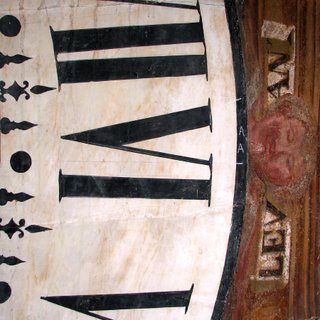
So when we stood among the turning wheels of the clock, listening to the perfect metronome tick of the gears, we were thrilled and shocked. People will tell you that small towns are different, that the people there are different... And it seems they are. In Clusone they're so nice that they'll take you up to their clocks and let you stand there listening to the 500 year old tick. And then - and here's the real kicker - they'll take you out on the scaffolding to stand at eye level with the clock face.

We climbed out a small window - you can see it to the right of the clock face in the above photo I found on an Italian website. See the rounded window to the side? We climbed out of that and onto the scaffolding. And there was the clock. And there we were... out on the scaffolding, with the clock keeper, in front of an ancient clock, in Clusone. How lucky can you get?
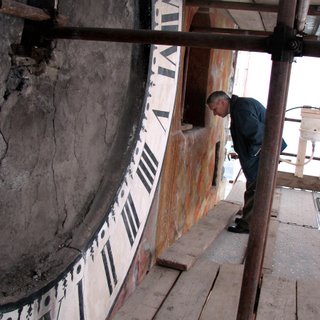
After our tour of the clock was over, and we'd heard its chimes and the preceding quickening of the gears, our guide took us on a tour of the rest of the town which included visits to locked churches and hello's to all of his neighbors along the way. A friend of his let us into a couple of closed churches and turned on the lights so that we could see the frescoes and art. Is there a grander tour than that?
Clusone is also known for two very famous fifteenth-century frescoes upliftingly titled "The Triumph of Death" and "The Dance of Death." As you might guess, there are skeletons involved. The colors in these frescoes are shockingly vivid and the imagery dramatic. These scenes look out over a pebbled piazza, surrounded by churches and mountains. On our Saturday the air was crisp and rain was coming, a certain grayness was pouring into town - and there we were. With our new friend and his friend and a small town full of their neighbors.

Our guide wanted us to see the town museum before we left on our bus but as it didn't open until 3:30pm (as I mentioned lunchtime is no joke in Italy) we stopped in a bar for coffee. He must have seen 3 neighbors on the way, and said hello to them all by name. He'd already told us that he considered this the most special part of a small town like Clusone, that you actually know your neighbors and are not just strangers on the street. After our coffee, we waited for the lady with the keys to arrive at the Museum, the town's clock watcher consulting his own watch several times and wondering why she was so late...
But can you really be late in Clusone when the town clock is covered and the clock-keeper's out for a walk with some folks from Chicago?


